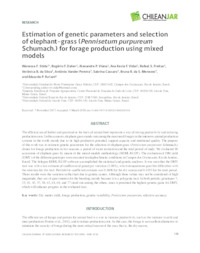Estimation of genetic parameters and selection of elephant-grass ( Pennisetum purpureum Schumach.) for forage production using mixed models.
Estimation of genetic parameters and selection of elephant-grass ( Pennisetum purpureum Schumach.) for forage production using mixed models.
Author(s): STIDA, W. F.; DAHER, R. F.; VIANA, A. P.; VIDAL, A. K. F.; FREITAS, R. S.; SILVA, V. B. da; PEREIRA, A. V.; CASSARO, S.; MENEZES, B. R. da S.; FURLANI, E. P.
Summary: The efficient use of fodder and grassland as the basis of animal feed represents a way of raising productivity and reducing production costs. In this scenario, elephant-grass stands out among the most used forages in the intensive animal production systems in the world mainly due to its high productive potential, support capacity and nutritional quality. The purpose of this work was to estimate genetic parameters for the selection of elephant-grass (Pennisetum purpureum Schumach.) clones for forage production in two seasons, a period of water restriction and the total period of study. We evaluated 80 accessions of elephant-grass by means of the mixed-models methodology (REML/BLUP). The evaluation of DM yield (DMY) of the different genotypes were executed in edaphoclimatic conditions in Campos dos Goytacazes, Rio de Janeiro, Brazil. The Selegen-REML/BLUP software accomplished the statistical and genetic analyses. It was seen that the DMY trait was with a low estimate of coefficient of genotypic variation (3.08%), which demonstrates possible difficulties with the selection for this trait. Heritability-coefficient estimate was 0.3606 for the dry season and 0.4193 for the total period. Those results were the variation in that trait due to genetic causes. Although those values may not be considered of high magnitude, they are of great interest for the breeding mainly because it is a polygenic trait. In both periods, genotypes 7, 25, 41, 43, 57, 58, 62, 64, 68, and 77 stood out among the others, since it presented the highest genetic gains for DMY, which will enhance progress in the evaluated trait.
Publication year: 2018
Types of publication: Journal article
Unit: Embrapa Dairy Cattle
Observation
Some of Embrapa's publications are published as ePub files. To read them, use or download one of the following free software options to your computer or mobile device. Android: Google Play Books; IOS: iBooks; Windows and Linux: Calibre.
Access other publications
Access the Agricultural Research Database (BDPA) to consult Embrapa's full library collection and records.
Visit Embrapa Bookstore to purchase books and other publications sold by Embrapa.

